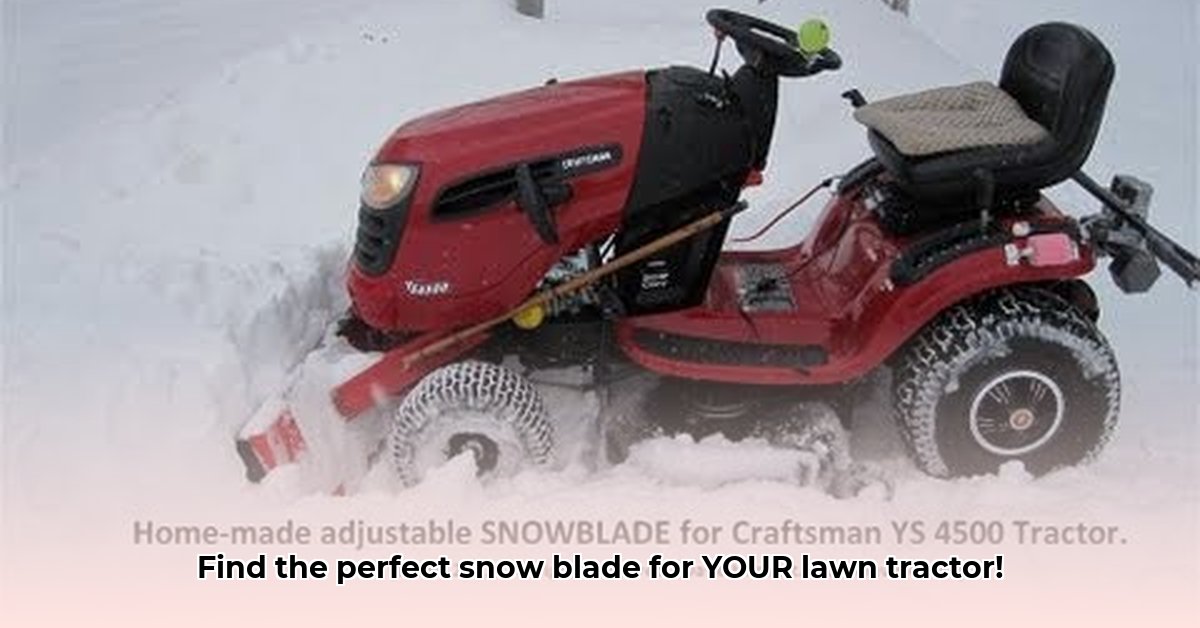
Winter's arrival brings the inevitable: snow. But before you're buried, consider the unsung hero of winter property maintenance: a snow blade for your lawn tractor. Choosing the right one can transform snow removal from a back-breaking chore into an efficient process. This guide helps you select, install, and use a snow blade effectively. For more options, check out used tractors and mowers.
Sizing Up Your Needs: Pre-Purchase Considerations
Before shopping, consider these key factors:
Tractor Compatibility: Your tractor's owner's manual specifies compatible attachments, weight limits, and hitch types. Ignoring this is risky and could damage your equipment. Ensure the snow blade's weight is well within your tractor's lifting capacity.
Snowfall Characteristics: Does your region experience light, fluffy snow or heavy, wet snow? Heavier snow demands a more powerful blade. Also consider the size of your property. A wider blade means fewer passes but might be too cumbersome for tight spaces. A wider blade generally requires more tractor horsepower.
Budget: Snow blades vary widely in price. Setting a budget beforehand prevents impulse purchases. Remember, the most expensive isn't always the best; choose the tool best suited to your needs.
Types of Snow Blades: Straight vs. V-Shaped
Two primary types exist:
Straight Blades: These are simpler, more affordable, and ideal for lighter snowfalls and smaller areas. They're easy to install and maintain.
V-Shaped Blades: Offering aggressive snow-pushing and throwing capabilities, these are best for heavier, wetter snow. The V-shape improves maneuverability in tight spaces.
Key Features to Consider
Beyond blade type, these features significantly impact performance:
Blade Material: Steel blades are durable but heavier, stressing your tractor. Poly (plastic) blades are lighter but may be less durable. The best choice depends on the balance of longevity and weight your tractor can handle.
Blade Width: A wider blade clears more snow per pass but demands more power. Consider your tractor's horsepower capacity.
Hydraulic Lift: This system simplifies raising and lowering the blade, saving time and effort. A must-have for large areas.
Angle Adjustment: Adjusting the blade's angle allows precise snow direction, crucial in confined spaces or around obstacles.
Installation: A Step-by-Step Guide
Installing your snow blade is typically straightforward (always consult your manuals first!):
Consult Manuals: Read both your tractor's and snow blade's instructions carefully. This is non-negotiable.
Secure Mounting Brackets: Attach the brackets to your tractor's hitch securely.
Align the Blade: Ensure proper alignment between blade and brackets. Double-check before tightening.
Tighten Bolts: Tighten all bolts firmly, avoiding over-tightening.
Test the Lift: Raise and lower the blade to confirm smooth operation.
Choosing Your Ideal Snow Blade: A Comparative Analysis
| Feature | Straight Blade | V-Shaped Blade |
|---|---|---|
| Cost | Lower | Higher |
| Snow Handling | Best for light snow | Best for heavy, wet snow |
| Maneuverability | Generally better in tight spaces | Better snow throwing and pushing capabilities |
| Maintenance | Simpler | May require slightly more maintenance |
How to Choose Based on Climate and Tractor Model
Dr. Emily Carter, Agricultural Engineering Professor at Purdue University, emphasizes, "Matching the snow blade to your tractor’s capabilities and your local climate is vital. Overloading the tractor can lead to mechanical failure."
Key Takeaways:
- The right snow blade depends on budget, snowfall, terrain, and personal preferences.
- Front-mounted blades are budget-friendly and suitable for light snow.
- Front-mounted blowers handle heavy snow but are more complex and costly.
- Rear-mounted attachments offer better visibility but can limit maneuverability.
- Always verify compatibility with your lawn tractor model.
Choosing the Right Snow Blade: A Step-by-Step Guide
- Assess Snowfall: Determine average snowfall amounts and type.
- Check Tractor Specifications: Verify weight capacity, hitch type, and PTO availability.
- Select Blade Type: Choose a blade or blower based on snowfall – a blade for light snow, a blower for heavy snow.
- Consider Features: Evaluate the importance of hydraulic lift, angle adjustment, and a trip edge.
- Compare Prices and Models: Research brands and models, comparing features and prices.
- Read Reviews: Check online reviews for insights into performance and reliability.
- Purchase and Install: Follow manufacturer's and tractor's instructions carefully.
Remember, a well-chosen snow blade makes winter property maintenance easier and more efficient. Happy plowing!